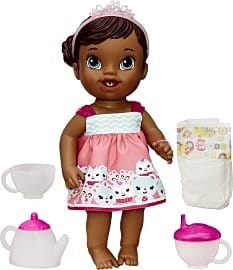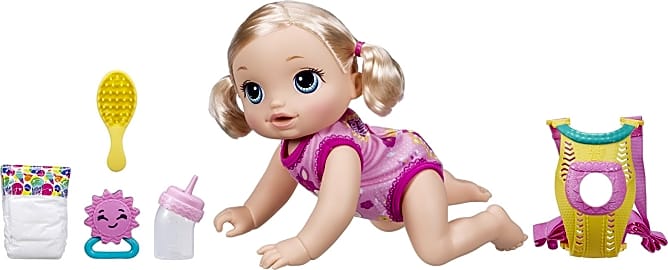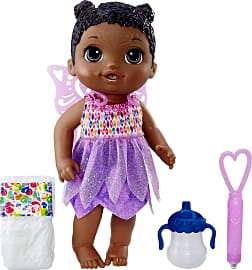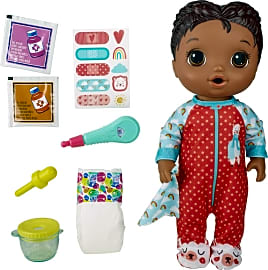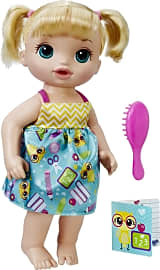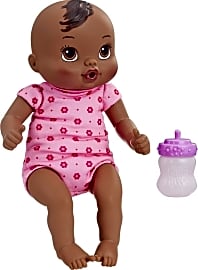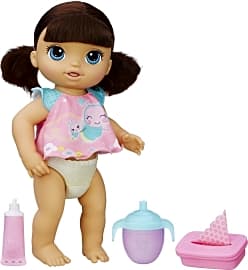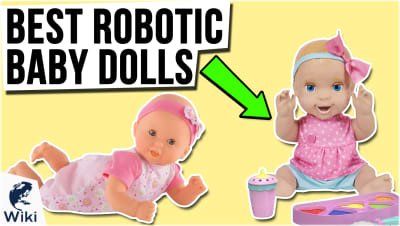The 10 Best Baby Alive Dolls

This wiki has been updated 38 times since it was first published in July of 2015. As technology advances, even the littlest members of our society can reap the benefits. Children will get the most realistic nurturing experience possible when playing with one of these Baby Alive dolls. Not only will your toddler fall in love with their wide eyes and adorable faces, but they'll love their ability to talk, sleep, eat, and even make a mess in their diapers. When users buy our independently chosen editorial picks, we may earn commissions to help fund the Wiki.
Editor's Notes
October 22, 2020:
Our list has been updated to reflect current availability and include newer models with even more fun features.
The unavailable Sips 'N Cuddles was replaced with the similar Luv 'N Snuggles, which also features an infant-sized, cushioned body and a bottle for feeding. This model is a bit more basic than the previous one, making it great for young children who don't yet have the motor skills to change a diaper, but would love to feed and cuddle baby. The Better Now Bailey was replaced with the newer, and arguably cuter, Mix My Medicine. While both of these options allow children to care for a sick baby, the latter comes with more items, like mixable medicine packets, stick-on band-aids, and a life-like thermometer. The 2018 Potty Dance was traded in for the following year's release, the fashion-forward Step 'N Giggle Brunette. Instead of learning to potty, she's learning to walk and her light-up shoes are super fun for kids.
March 28, 2019:
We updated our selection to include some of the newest Baby Alive dolls that offer even more interactive opportunities for children to enjoy these adorable dolls.
The Real As Can Be model incorporates movement and realistic responses to your child's actions, and although she doesn't wet her diaper like most Baby Alive dolls, some parents will prefer it because they don't have to purchase any replacements. With over 80 sounds she mimics a real baby, and could be a great gift for family expecting a new baby. The Potty Dance takes the wetting interaction to a new level by providing a potty instead of diapers to help children understand potty learning better.
The Doll As A Training Device
The dolls are available in Caucasian, African-American, and Hispanic varieties.
Baby Alive dolls are lifelike recreations of babies that are capable of doing many of the same things that real live babies do. They can eat, drink, cry, and even wet themselves. The dolls are available in Caucasian, African-American, and Hispanic varieties.
There are several reasons boys and girls can benefit from playing with dolls. Children become very attached to their Baby Alive doll and will do anything to keep it happy. Since young kids can be prone to aggression towards objects, the compassion they learn to have for their dolls is very useful. They learn through their toy that if they don’t treat it with care, it cries or in some way shows distress. Children transfer some of the empathetic understanding they learn from their doll to real life humans. As such, it is an ideal way accustom a young child to the idea of a sibling.
Baby Alive dolls can also help first-time mothers get ready for motherhood. Practicing parenting on objects is not a new technique - it's been proven to be effective for decades - but the Baby Alive doll brings more realism to the process. Baby Alive dolls can train mothers in knowing how often babies need to be fed, how long nap time should be in order for a baby to feel rested, and other important aspects of motherhood. The doll acts as an effective training apparatus, and is the closest thing that a new mom can experience to having a real baby.
The History Of The Baby Alive Doll
The first Baby Alive doll came onto the market in 1973, when Kenner Products introduced a doll that could eat, drink, and wet itself. The first model was more aesthetically simple than current ones, but the designers have followed the growing trend to make dolls appear more realistic. All models throughout the years have featured a mechanical mouth that can be spoon-fed packets of food mixed with water. Each box in the 1970s came with the doll, a bottle, diapers, the food packet, and a feeding spoon. The dolls would chew and swallow their food, and eventually convert it into waste that ended up in their diapers. Sometimes the dolls would vomit.
The doll was instantly a success and by the mid 1970s it was in high demand. In 1992, Kenner released a doll that went to the bathroom in a potty instead of a diaper, could swallow without the use of a lever, and could speak. The doll would say things like, “I have to go potty” and “All done now.” Consumers complained that the baby had an oddly adult voice, and the 1992 model did not sell as well as the original. The next model was released in 1995 and came with snacks and juice boxes. There were two versions of the 1995 doll — Baby Alive and Baby All Gone. Baby Alive soiled itself, but Baby All Gone didn't actually consume food - it only mimicked the action. Kenner made some adjustments to the baby’s food and beverage over the years, like packaging the juice in bottles instead of cardboard boxes to cut back on waste, and offering cookies that kids could actually bake.
In 2006, after Kenner merged into Hasbro, the latter took over the manufacturing of Baby Alive dolls, and produced over a dozen models with special accessories that were designed to teach different skills.
How To Choose From Among So Many Models
Among Baby Alive dolls, you'll notice that there are two primary categories: toddlers and newborns. Each of these model categories has its advantages, and choosing between them will put the focus on the most important variable in your overall decision, namely the age of the intended recipient. The younger and smaller the child in question, the more appropriate the smaller newborn models will be. Older kids stand to gain more–and have an easier time handling–the larger toddler models.
Older kids stand to gain more–and have an easier time handling–the larger toddler models.
Newborn models are ideal if they're intended for a child you want to train toward caring for, or at least caring about, a new sibling. If you're particularly smart about it, you might just find a way to get your older children excited about changing their little brother or sister's diapers, relieving you of a rather tiresome task. The major downside to the newborn Baby Alive dolls is that, like newborns themselves, they're capable of fewer feats, and are less diversified in personality than their more developed counterparts.
Toddler models, on the other hand, come in a wide array of styles, ranging from simple kids with simple tastes to the kind of little ones that constantly have a ton of toys and treats within arm's reach. Coincidentally, the dolls designed to interact with more stuff tend to be a little more expensive, much in the way that a needier, higher-maintenance child will cost its parents a little more money.
Certain of these toddler dolls stand to teach children about how to conduct themselves in life, as well, preparing them to encounter real world situations like starting to go to school, or heading to the doctor for the first time. With the experience of their dolls fresh in their minds, young children may have an easier time adjusting to changes and experiences in their own lives that might otherwise prove stressful to parent and child.
Fortunately, the budget range for these dolls is pretty thin, so you don't have to choose between terribly classist model options. It is worth noting, however, that the included diapers are not reusable, and that once the dolls soil them, they have to be replaced. Real world diapers for real, live babies get expensive fast, and diapers for Baby Alive Dolls are no different.




